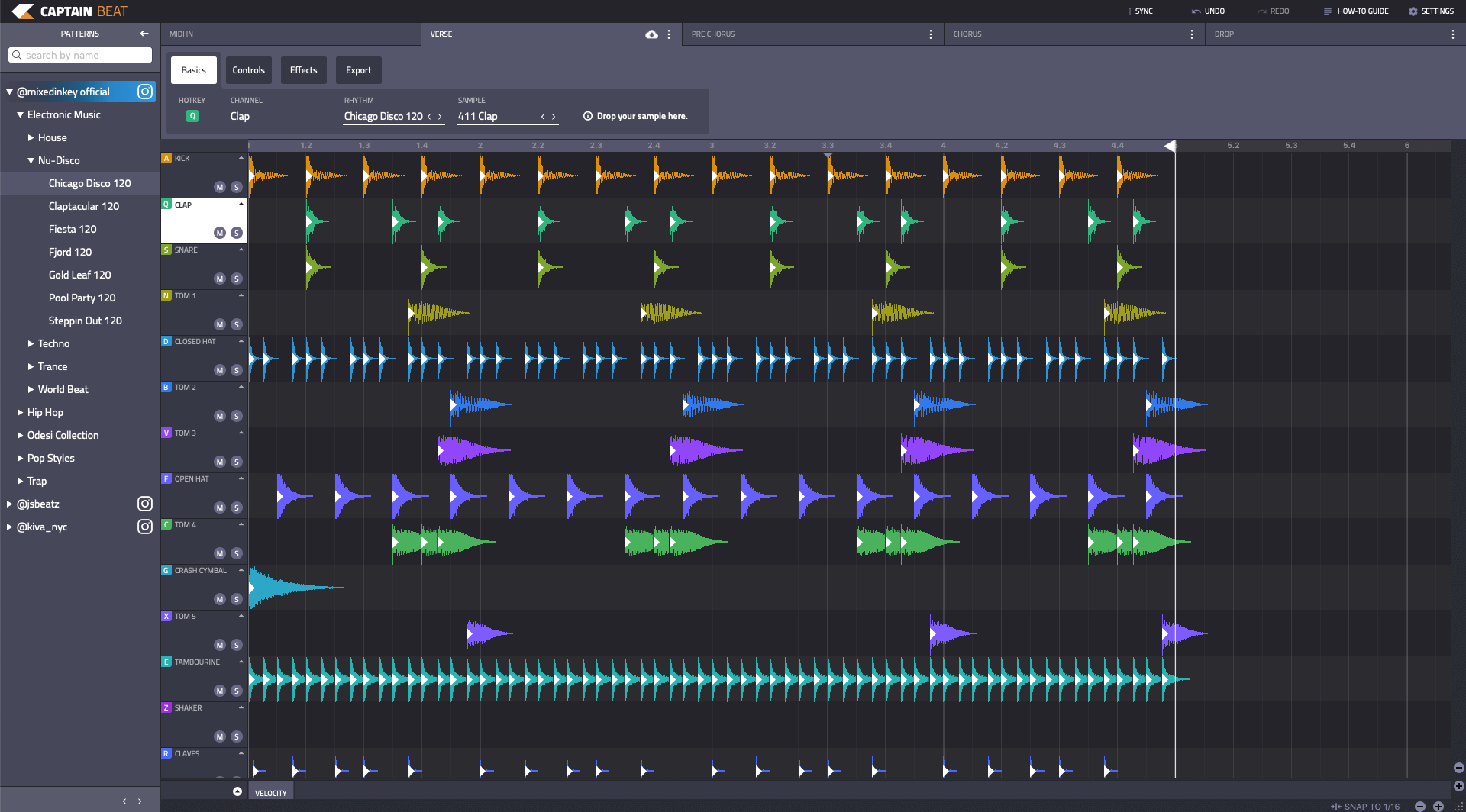How to program great drums.
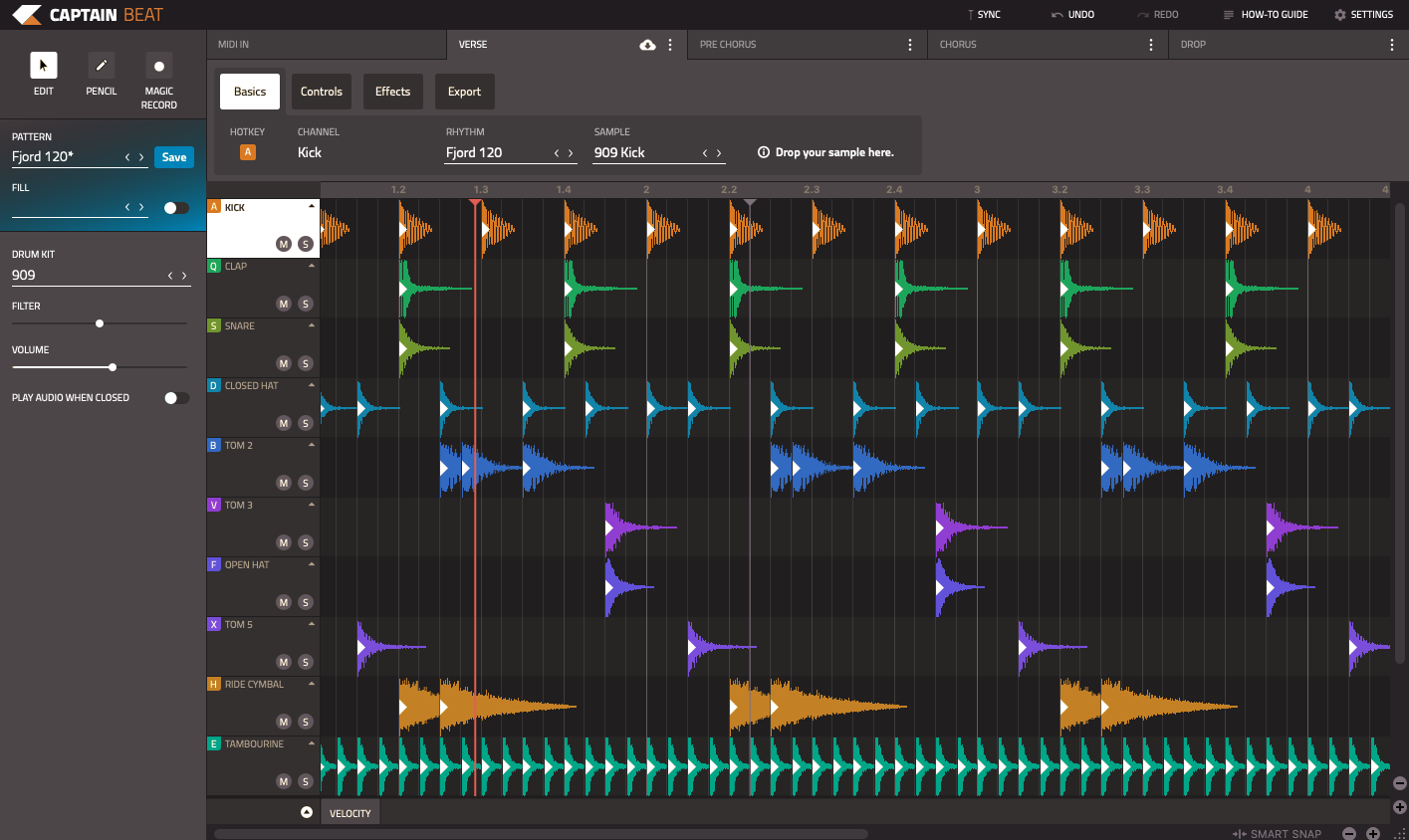
The earliest music was purely percussive. Hitting animal skins and sticks fulfilled humankind’s natural need for rhythm. Drums, you could argue, are the first thing we ever hear – our mother’s heartbeat in the womb. A steady, consistent, pulsing rhythm that soundtracks our first 9 months of existence. Music is born from drums. Drums are born from living.
Programming drums is fun, and it’s fairly easy to create perfectly adequate drums. But let’s aim higher and turn good drums into great ones.
1. What is a drum pattern?
A drum pattern is a looped collection of rhythms that drive the music that plays over it. Drum patterns and tempo dictate much of the energetic force of the music. As such, it’s incredibly important to craft drum patterns that sufficiently match the intended energy and style of the track, and transition beautifully between sections. Drums tell us when we’re supposed to be dancing to the music, and when we can pause. They tell us when we can expect a new section to appear, and can stir up adrenaline-fuelled anticipation of a soon-arriving chorus or drop.
Put simply, drums tell the listener what to expect from the music.
Instinct Vs intellect.
When a ‘real’ drummer plays the drums, they’re playing a drum pattern, but they’re executing it on the fly. There’s a bit of spontaneity because humans rarely do the exact same thing twice. So even if they’ve practiced it to death, they might alter the drum pattern either through mistakes, reacting to other musicians or just spontaneous inspiration. While this type of ‘live drum programming’ requires a lot of performance skill, it also takes a fair amount of brain power. The old trope that drummers are the dumbest member of the band is a total myth! Drumming requires a full understanding of how the drums energise the song, where the song is going, how the transitions between sections need to be executed, and how hard or soft they need to play.
Studio based drum programming requires the exact same considerations, but we get the luxury of not having to do it on the spot. We can take our time and consider exactly what we want to achieve at our leisure.
This is a good, and a bad thing. In music, as in life, too much time to think can be dangerous – live drummers have no room for self-doubt or overthinking! It’s also sometimes healthy to lay down rhythmic ideas by instinct. If you have a half-decent sense of rhythm, you’ll have a natural affinity with grooves and beats. Trust yourself to go with the flow… you can always edit and tweak later.
Of course, this depends on your workflow, which we’ll come to later. Some producers prefer to lay their beats down one hit at a time, one channel at a time. This suits those of us not blessed with great rhythm, and those whose brains simply prefer a more mathematical approach. There’s no right or wrong way to program drums. But if we want to program great drums, we need to understand the opportunities and limitations of different methods, and a clear understanding of what we’re aiming for.
Dance to the beat of a different drum machine.
Captain Beat 5.0: The Ultra-Modern Beatmaking Plugin
- Mix and match rhythm patterns per-channel
- Hundreds of high-quality drum sounds
- Play and record rhythms with computer keyboard or MIDI controller
- Sophisticated MIDI editing
- Add your own samples
- Wave-form visualizer
- Advanced audio and MIDI export options
2. Identify what you’re trying to achieve. How close do you want to follow the style guide for specific genres?.
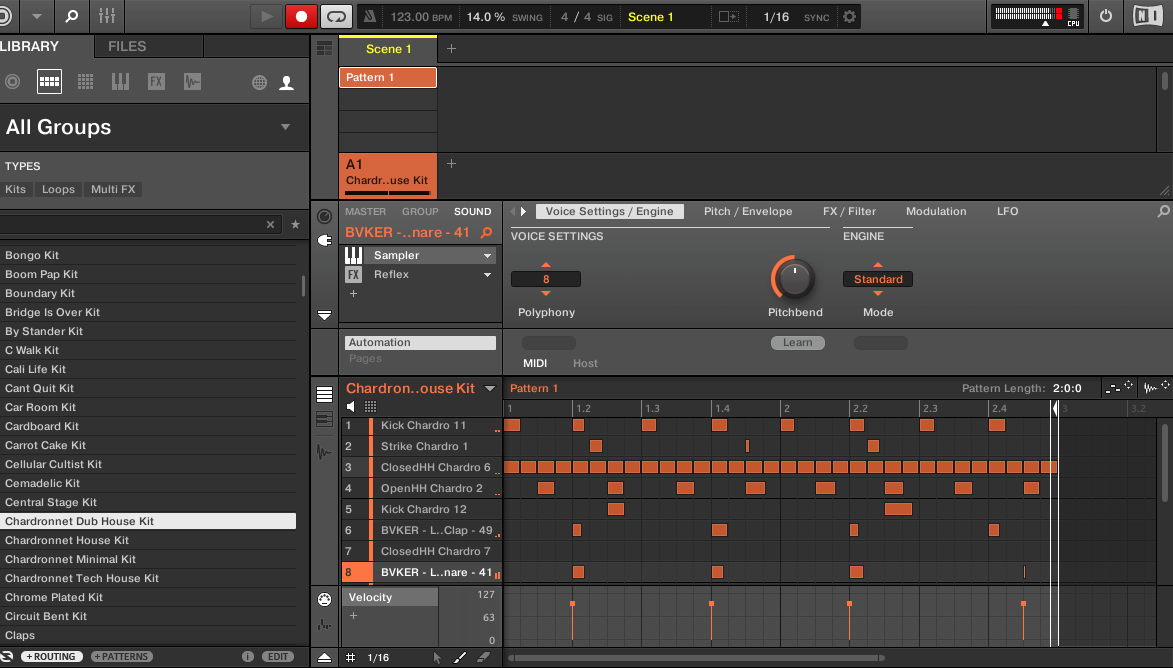
This boils down to who you are as an artist, and what your track is trying to achieve. Many producers want to create music for others to dance to, which often involves incorporating a significant degree of predictability into our drums. It’s normal – people dance more freely when they can predict where the beat is taking them.
Many people go to a specific club-night or event because they know what sort of music they can expect. They like it, they know they enjoy dancing to it, and they want it!
Other producers might be making music intended for home listening, or in genres such as Neo-Soul, Broken-Beat or other Jazz-infused styles that have a greater degree of freedom associated with them. It doesn’t really matter which it is, and there is always value in being bold and experimental, but don’t be confused. Know what you want to achieve in advance and go for it.
Certain genres have clear principles. House music and all its subgenres have a clear reliance on a 4/4 kick pattern, and more often than not off-beat open hats, a 2/4 snare and syncopated claps. The same goes for Disco.
Meanwhile, Trap usually has lots of 1/32 triplet hi-hats, long 808 kick drums and electro style snares. Dubstep and Garage use 2-step rhythms for kick and snare, while Hip-Hop rarely exceeds 110bpm.This isn’t to say rules aren’t there to be broken, but we need to identify the genre standards we’re aiming for and decide whether to comply or experiment. But how do we do that?
One word: Listen!
Any regular readers of this wiki will recognise this advice from many other articles. The secret to understanding your own music is to understand other’s. Devour music voraciously and try to deduce what methods are employed, how they achieve their successes and which parts you particularly admire, or dislike. Training your ears is the most fundamental part of music production and is no less relevant for programming great drums!
3. Bass and kick drum must complement each other.

There isn’t one true way to start a song. Some producers start with drums, others with chords. Or melodies. Or samples. For most of us, it’s a mixture, totally dependent on our inspiration, mood and access to equipment.
However you begin your track, you’ll ultimately need to strike the perfect balance between bass and kick drum. Both in terms of sonic compatibility and pattern, the kick and bass sounds must play nicely together. It’s the meat of your track, the most dominant frequencies and the most driving element of the ensemble music.
The kick drum’s job is to drive the whole track. It’s the lifeforce of any song. Meanwhile, the bass instrument is the all-encompassing blanket of sound; the wall of low and midrange frequencies that makes us feel the music. But, when the two clash, it’s discombobulating. The music seems to fall apart as the two dominant forces fall out of step with each other. In short, it sucks!
Let’s consider the basic functions of each:
Kick drums have:
- A sharp attack.
- Little harmonic register (usually a single fundamental and some much quieter harmonics).
- A short decay (unless it’s used as a bass instrument, such as in lots of Trap music).
- Limited transient detail.
Bass instruments have:
- A low to even attack.
- Lots of low and midrange harmonics.
- A long to very long decay.
- Often have limited transient detail.
So what does this all mean?
Well, in most cases, kicks are short, sharp single-note low sounds. They often have most of their harmonic information at frequencies below the human ear’s register, so tonality is less important. Synthesized kicks may have an audible click, and acoustic kicks may have a beater sound, both registering in the upper mids. But, these transient sounds are usually much quieter and also inharmonic.
Meanwhile, bass instruments may also have limited/quieter transients, since the primary function is to register in the lower end. High transient detail can take up space for other instruments.
Also, bass instruments generally have a much less pronounced attack, and a decay which is longer than the kick drum. Sometimes it’s a hanging note that may play over several kick drum hits.
We can use this information to our advantage.
Because we know that kicks have sharp attacks and short decays, and bass instruments have the oppposite, we can use the kick as articulation for the bass. In other words, the kick can announce the arrival of a new bass note and draw attention to it. This is why many effective kick drum/bass patterns follow the exact same rhythm. Each time the kick hits, so does the bass. The bass sound continues, providing all that lovely body. We’re used to hearing this technique – all the way back to orchestral music through jazz, blues, rock and right up to present day.
So the kick always follows the bass rhythm?
If only it were that simple! As with most aspects of music production, this rule is there to be broken. Many tracks use off-beat bass rhythms to deliberately avoid the kick drum pattern. This can result in an additional low-end rhythm that serves as another driving force in the song. As a result, it’s usually employed when a song needs to be even more exciting than it would be otherwise.
Similarly, the bass and kicks can effectively syncopate with each other, providing additional rhythmic energy in a more idiosyncratic manner. The big caveat to these exceptions is to ensure the bass and kick sounds share a similar attack energy, or the interplay between them may sound imbalanced.
4. Use the right sounds.
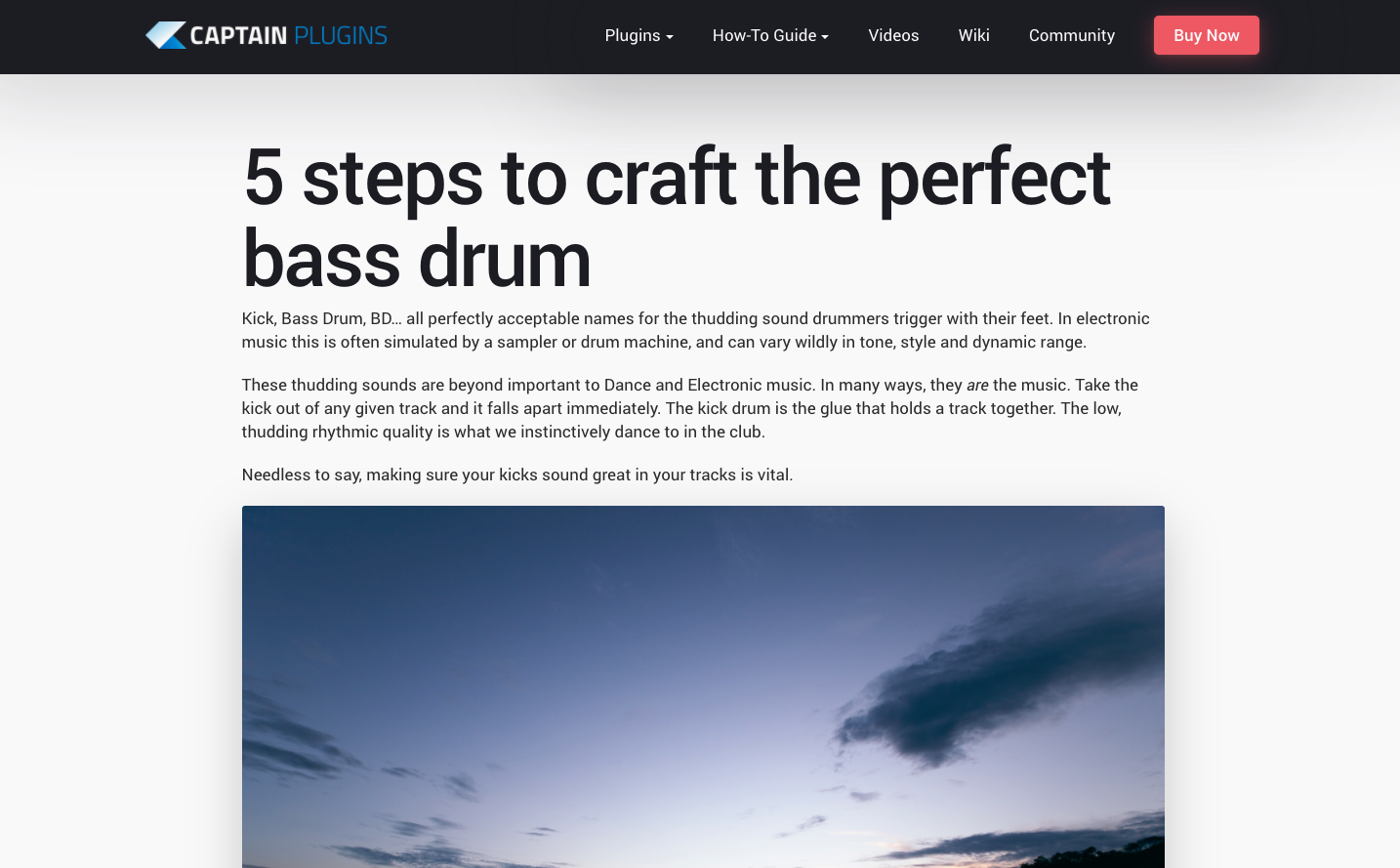
Different drum sounds can make the same pattern sound completely different. One of the key advantages of using a MIDI-based drum machine such as Captain Beat is the ability to substitute samples as you go. You can try out completely different drum sounds in the same pattern – a fast and convenient way of finding the right sounds for your drum beat.
These days, there are an endless array of high-quality sample packs available… many for free! From sampled drum machines to acoustic recordings, genre-specific composite sounds and even label/artist curated sample packs, there are enough sounds to stock you up for life.
The battle, often, is knowing which sounds to settle on.
This is one of those questions that nobody can answer but yourself.
However, here’s a little checklist that might help:
- Body: does the sound have enough weight?
- Tone: Does the sound have tonal information, and if so, how does it sound ensemble?
- Attack: Is it right for the beat?
- Decay: Does the sound tail fade out in a way you can work with? Too long can be faded out manually, but too short can’t be extended.
- Relative dominance: Where should this sound sit in the mix? Does it have adequate impact for the job?
- Frequency balance: Any wild spikes? If so, can they be contained? Remember that drum beats rarely like imbalanced frequency peaks.
- Collateral frequencies: Are there artefacts present, such as other drums or room ambience in samples? This doesn’t necessarily signify a problem, but you’ll need to manage the sound carefully to maintain balance.
Can’t you just process any sound until it fits?
Sure, much of the above considerations can be mitigated by smart processing. EQ, panning, compression, envelope manipulation and volume can bed drum sounds together in most circumstances. But, while a little sound manipulation is fine, with so many samples and sound to choose from, why waste time overworking sounds that don’t want to fit nicely? Move on to a new sound, comrade.
5. Repetition Vs variation.
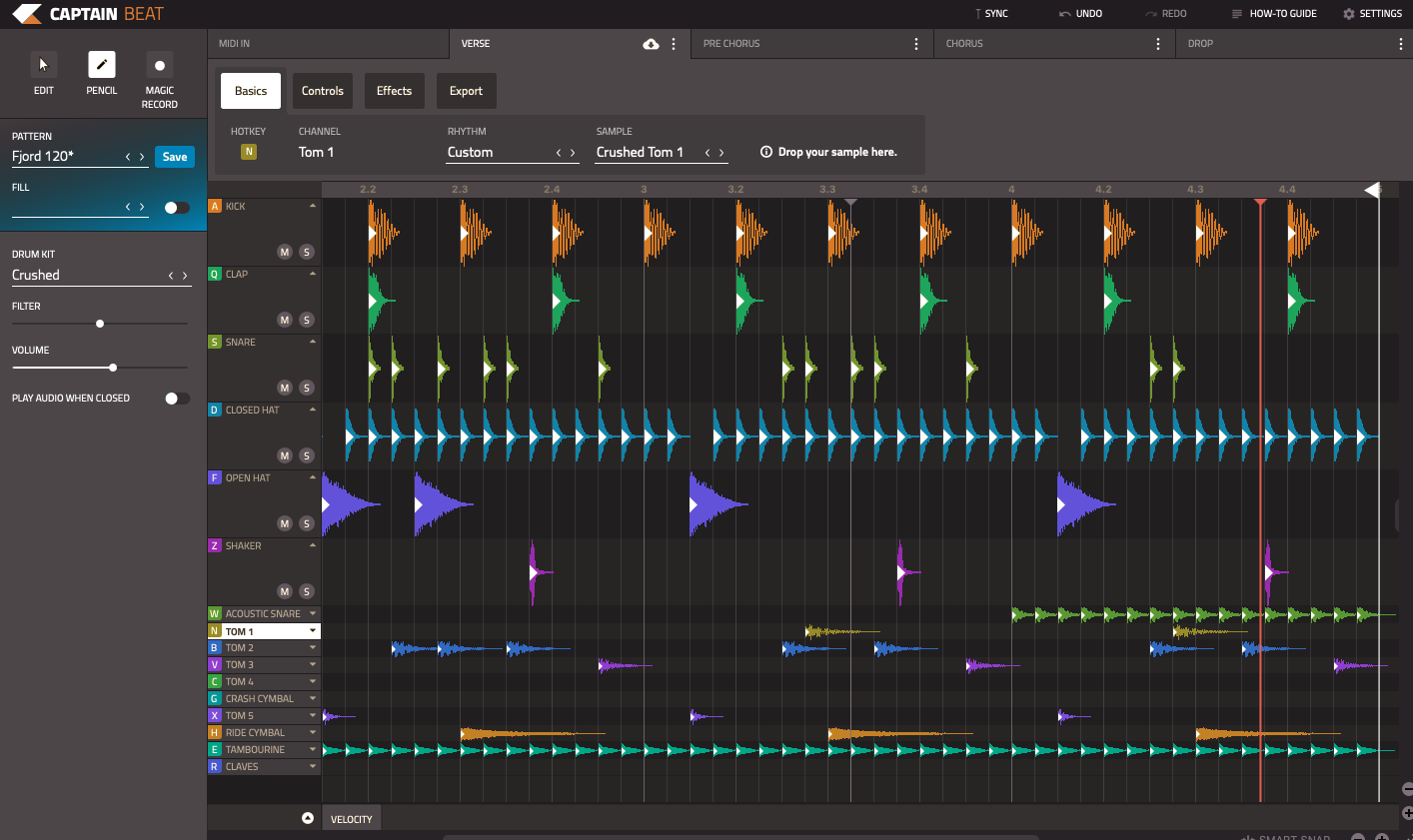
Programming drums is a balancng act between repetition and variation. Much like a melody, if your drum pattern is forever changng, it becomes rootless. It’s harder to connect with, leaving it unlikely to achieve popularity on the dancefloor, the radio or anywhere outside niche audiences.
Generally, we want a fair amount of repetition, especially in the fundamentals such as kick, snare and claps. However, the same 2-bar drum loop all the way through a song is likely to be boring. Try to add some variation, without trashing the groove you’ve built up, or over-complicating things. Sometimes, taking things out can be just as effective as adding them. So don’t be afraid to strip a beat back for certain sections, or trigger some percussion sounds every other loop rather than each cycle.
Fill your boots.
Drum patterns can also be great for signposting transitions and new sections. A classic way to achieve this is using a drum fill. Captain Beat is the only drum VST plugin on the market with a dedicated fill tool, by which you can craft unique fills by editing one of the dozens of on-board fill patterns. This is an amazing way of introducing additional drama and anticipation during transitions!
Here are some other ideas for adding variation to your drum patterns:
- Take sounds away to create dramatic tension.
- Extend decay times of hi-hats towards the end of occasional patterns.
- Introduce a new sound/rhythm on a 4-bar, 8-bar or 16-bar cycle. The repetion maintains consistency, but the low frequency adds surprise.
- Remove fundamentals like kick and/or snare at the beginning or end of occasional sections. This can act as a dramatic pause.
- Alternate sounds in the same pattern, so one plays on bar 1, the next the same pattern on bar 2, then back to sound 1 on bar 3.
- Emplay a crash to mark the start of important sections.
- Create a fill to bring in new sections.
Of course, there are many more ways to add variation, but these should give you a solid launch-point.
Write Chords Faster with Captain Chords
- Use Captain Plugins to write your own Chord Progressions, Hooks, Melodies and Basslines
- Export to your DAW
- Available on Mac and Windows.
6. Percussion. Fill in the gaps between kick and snare.

When looking at your drum grid, you’ll notice that it’s called a grid for a reason. You populate drum hits across (usually) 16 channels to craft a beat. Looking at it as a large grid can be very useful, as you can see where the kick and snare beats already are. This helps with programming the rest of the percussion, as you can avoid colliding midrange-heavy percussion like congas, toms and bongos with bass drum and snare. Meanwhile, your metals, like closed and open hi-hats, can collide with more freedom.
In addition, by avoiding the kick and snare hits as a general rule, you can often find interesting syncopation, which helps your program great drums full of life and energy.
Mash-up generic conventions.
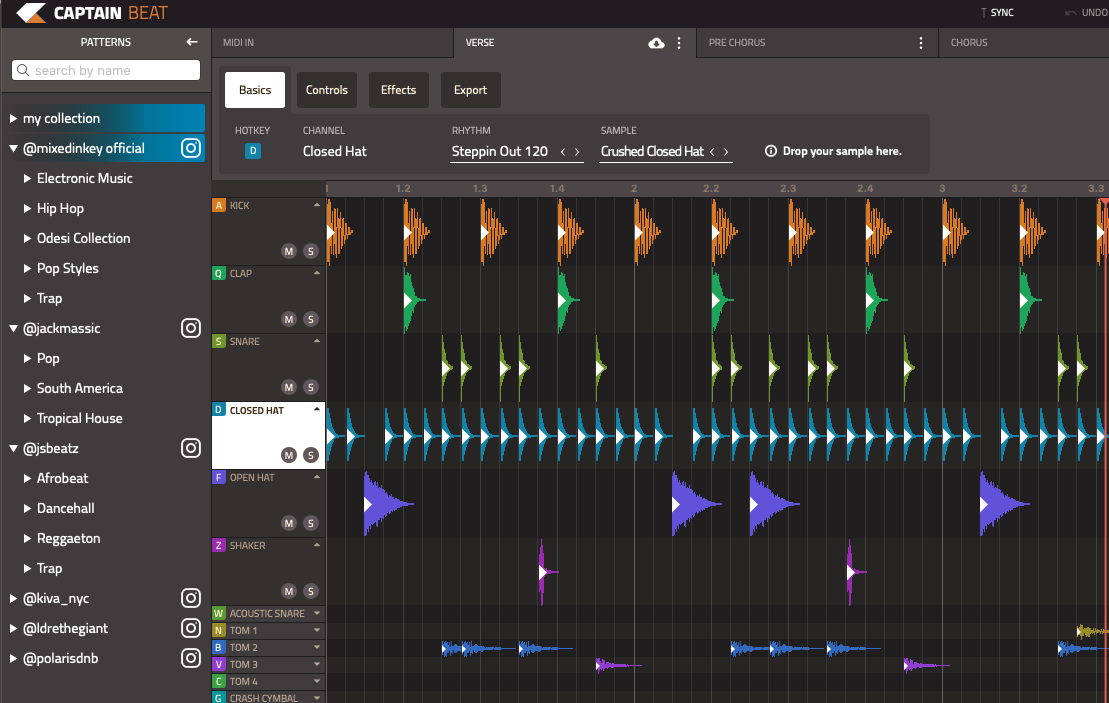
One of the coolest options in Captain Beat is per-channel rhythm substitution. It’s no accident that we designed it this way. We know that innovative new ideas can come about by combining patterns traditionally seen in one genre, with another genre’s patterns on different instruments. For instance, try combining Techno ride or hi-hat patterns with Dub or Afrobeat kicks and snares. Or, Trap hi-hats with Pop percussion and Rock-style acoustic drums on kick and snare. It’s a fast-track to innovation!
7. Embrace Swing – groove makes drums danceable.
Whether it’s called Swing or Groove (different plugins and machines vary), it’s a wonderful way to inject life into a stale drumbeat. You can define Swing as a programmed, deliberate variation in how the rhythm of a drum rhythm aligns with the overall project tempo. Sometimes it’s added in a percentage form from 1-100% (100% being extreme, 1% being basically unnoticeable.). Other times it’s categorized as 1/8ths or 1/16ths between 50 and 75% (the classic MPC divisions). They basically mean the same thing, and experimenting within these parameters will bring out magic in your drum patterns.
Many of the drums in this pattern are slightly off the beat, or swung. This adds a human-like groove to it. By also adjusting velocity of various drums, we can make it sound much more human.
8. Tune your drums to your track’s root key.
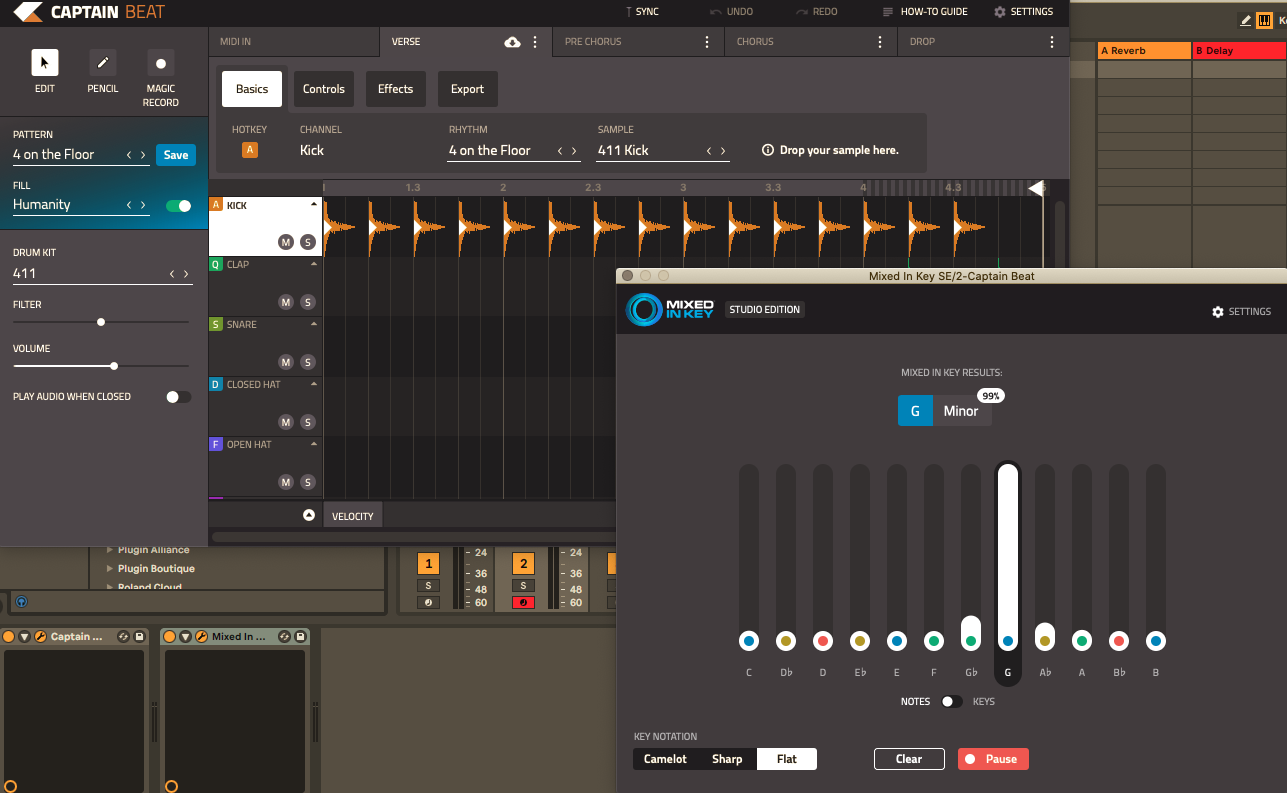
This is specifically for tonal drums, like toms, bass drums, snares and congas.
One of the tell-tale mistakes that rookie producers make is not tuning their drums. Out of tune drums clash with the music and give the listener an unsatisfying experience.
Bass drums are essentially just low tones, and as such need to be in tune with the key of your track. Some kicks are comprised entirely of such low frequencies (below 80Hz or so) that the human ear can’t really pitch it – and thus they don’t need to be tuned. However, most kicks are made up of two parts – the thud (low end) and the snap (top end). If the snap end is out of tune with your track, it sounds bad.
Enter Mixed In Key Studio Edition.
With our unique plugin for producers, you can now determine the exact pitch of a sample in real-time, inside your DAW. You can also use it to determine the overall key of your track, which makes finding the right drum samples child’s play.
About the author:

